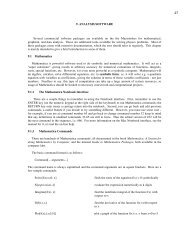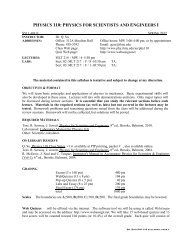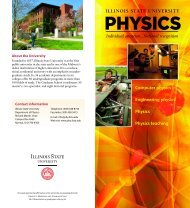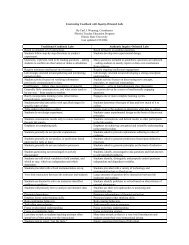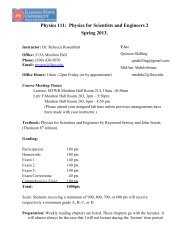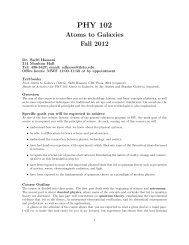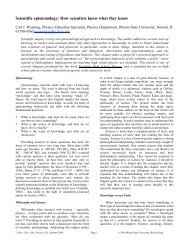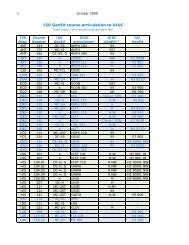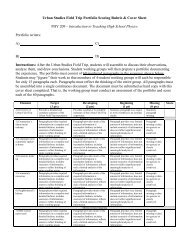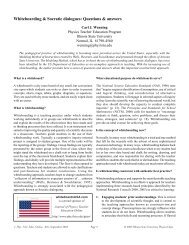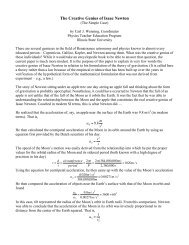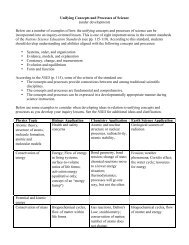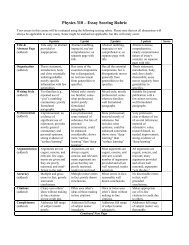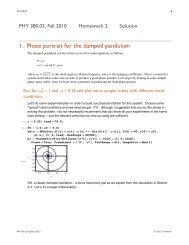Unit I - Worksheet 3: Coulomb's Law
Unit I - Worksheet 3: Coulomb's Law
Unit I - Worksheet 3: Coulomb's Law
You also want an ePaper? Increase the reach of your titles
YUMPU automatically turns print PDFs into web optimized ePapers that Google loves.
Name<br />
Date<br />
Pd<br />
<strong>Unit</strong> I - <strong>Worksheet</strong> 3: <strong>Coulomb's</strong> <strong>Law</strong><br />
1. Given the mathematical representation of Coulomb’s <strong>Law</strong>, F = k q 1q 2<br />
r 2<br />
, where<br />
k = 9.0 ×10 9 Nm 2 C 2 , describe in words the relationship among electric force, charge, and<br />
distance.<br />
2. By how much does the electric force between a pair of charged bodies diminish when their<br />
separation is doubled? tripled?<br />
3. The most common isotope of hydrogen contains a proton and an electron separated by about<br />
5.0 x 10 -11 m. The mass of a proton is approximately 1.7 x 10 -27 kg. The mass of the electron is<br />
approximately 9.0 x 10 -31 kg.<br />
a) Use Newton's law of universal gravitation to calculate the gravitational force between the<br />
electron and proton in the hydrogen atom.<br />
b) Use 1.6 x 10 -19 C as the elementary unit of charge to determine the force of attraction<br />
between the two particles.<br />
c) How many orders of magnitude greater is the electric force between the two particles than<br />
the gravitational force between the two particles? How important are gravitational force<br />
effects in this case?<br />
©Modeling Workshop Project 2005 1 E1-Charge&Field ws3 v3.0
4. Two charged spheres are on a friction-less horizontal surface. One has a charge of +3.0 x 10 -6 C,<br />
the other a +6.0 x 10 -6 C charge. Sketch the two spheres, showing all forces on them. Make the<br />
length of your force arrows proportional to the strength of the forces.<br />
5. Two positive charges of 6.0 x 10 -6 C are separated by 0.50 m. Draw a force diagram for each of<br />
the charges, considering only electrostatic forces. What is the magnitude of the force between<br />
the charges? Is this force repulsive or attractive?<br />
6. A negative charge of 2.0 x 10 -4 C and a positive charge of 8.0 x 10 -4 C are separated by 0.30 m.<br />
What is the magnitude of the force between the charges? Is this force repulsive or attractive?<br />
7. A young man accumulates a charge q 1 of +2.0 x 10 -5 C while sliding out of the front seat of a<br />
car. His girlfriend, who had been waiting in the wind, has picked up some extra electrons and<br />
now has a charge q 2 of -8.0 x 10 -5 C.<br />
Draw a sketch of the situation. Estimate the magnitude of the electrical force that each person<br />
exerts on the other when separated by a distance of 6.0 m. Is the force attractive or repulsive?<br />
©Modeling Workshop Project 2005 2 E1-Charge&Field ws3 v3.0
8. Suppose the two people in the previous problem move toward each other. Calculate the<br />
magnitude of the electrical force of one on the other when their separation is reduced by a factor<br />
of 10.<br />
9. Two pith balls shown in the diagram below have a mass of 1.0 g each and have equal charges.<br />
One pith ball is suspended by an insulating thread. The other charge is brought to within 3.0 cm.<br />
of the suspended ball (r = 0.03 m). The suspended pith ball is deflected from its rest position<br />
until the thread forms an angle of 30˚ with the vertical. At this angle, the ball is in equilibrium.<br />
a) Draw a force diagram depicting the forces acting on the suspended ball.<br />
Calculate (b) mg (c) F e (d) the charge on the pith balls<br />
©Modeling Workshop Project 2005 3 E1-Charge&Field ws3 v3.0
10. The figure below shows three point charges that lie along the x axis. Determine the magnitude<br />
and direction of the net electrostatic force on charge q 1 .<br />
-4.0 x 10 -6 C<br />
+6.0 x 10 -6 C -7.0 x 10 -6 C<br />
q 2 q 1 q 3<br />
0.20m 0.15m<br />
11. Three charges are placed as shown below. Determine the magnitude and direction of the net<br />
electrostatic force on charge q1. As part of the solution, include a force diagram.<br />
+1.8 x 10 -5 C<br />
q 3<br />
3.0 m<br />
-1.2 x 10 -5 C +4.5 x 10 -5 C<br />
q 2 q 1<br />
3.0 m<br />
©Modeling Workshop Project 2005 4 E1-Charge&Field ws3 v3.0



